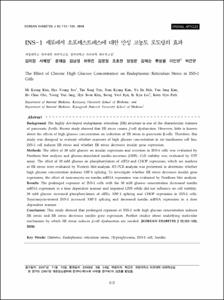KUMEL Repository
1. Journal Papers (연구논문)
1. School of Medicine (의과대학)
Dept. of Internal Medicine (내과학)
INS-1 세포에서 소포체스트레스에 대한 만성 고농도 포도당의 효과
- Alternative Author(s)
- Kim, Mi Kyung; Cho, Ho Chan; Kim, Hye Soon; Ryu, Seong Yeol; Park, Keun Gyu
- Journal Title
- Korean Diabetes Journal
- ISSN
- 1976-9180
- Issued Date
- 2008
- Abstract
- Background: The highly developed endoplasmic reticulum (ER) structure is one of the characteristic features of pancreatic β-cells. Recent study showed that ER stress causes β-cell dysfunction. However, little is known about the effects of high glucose concentration on induction of ER stress in pancreatic β-cells. Therefore, this study was designed to evaluate whether exposure of high glucose concentration in rat insulinoma cell line, INS-1 cell induces ER stress and whether ER stress decreases insulin gene expression. Methods: The effect of 30 mM glucose on insulin expression and secretion in INS-1 cells was evaluated by Northern blot analysis and glucose-stimulated insulin secretion (GSIS). Cell viability was evaluated by XTT assay. The effect of 30 mM glucose on phosphorylation of eIF2α and CHOP expression, which are markers of ER stress were evaluated by Western blot analysis. RT-PCR analysis was performed to determine whether high glucose concentration induces XBP-1 splicing. To investigate whether ER stress decreases insulin gene expression, the effect of tunicamycin on insulin mRNA expression was evaluated by Northern blot analysis. Results: The prolonged exposure of INS-1 cells with the 30 mM glucose concentration decreased insulin mRNA expression in a time dependent manner and impaired GSIS while did not influence on cell viability. 30 mM glucose increased phosphorylation of eIF2α, XBP-1 splicing and CHOP expression in INS-1 cells. Tunicamycin-treated INS-1 increased XBP-1 splicing and decreased insulin mRNA expression in a dose dependent manner. Conclusion: This study showed that prolonged exposure of INS-1 with high glucose concentration induces ER stress and ER stress decreases insulin gene expression. Further studies about underlying molecular mechanism by which ER stress induces β-cell dysfunction are needed.
연구배경: 최근의 연구들은 췌장베타세포의 기능장애 유발과 제2형 당뇨병의 발병에 소포체스트레스의 증가가 중요한 역할을 함을 보여주고 있다. 그러나 현재까지 고혈당에 의한 포도당 독성이 췌장베타세포에서 소포체스트레스를 유발하는지와 소포체스트레스가 인슐린유전자의 발현에 미치
는 효과에 대한 연구는 미진한 상태이다. 따라서 본 연구자들은 고혈당이 쥐의 인슐린종 세포 주에서 소포체스트레스를 유발하는지와 소포체스트레스 유발이 인슐린유전자의 발현에 미치는 영향을 알아보았다. 방법: 쥐의 인슐린종 세포주인 INS-1 세포를 고농도 포도당에 노출시켰을 떄 인슐린 발현과 포도당 자극 인슐린분비에 미치는 효과를 측정하였다. 고농도 포도당이 INS-1 세포의 사멸에 미치는 영향은 XTT 분석을 통해 확인하였다.
고농도 포도당이 INS-1 세포에서 소포체스트레스를 유발하는 지를 eIF2α의 인산화 정도와 CHOP의 발현 변화를 웨스턴 블롯을 통해 확인하고 XBP-1의 splicing을 역전사 중합효소 연쇄반응을 통해 확인하였다. 소포체스트레스의 유발이 인슐린유전자 발현에 미치는 영향 알아보기 위해 INS-1
세포에 tunicamycin을 처리하고 인슐린 mRNA의 변화를 노던 블롯을 통해 확인하였다. 결과: INS-1 세포에 고농도 포도당을 처리하였을 때 인
슐린 mRNA 발현은 시간이 지날수록 감소하였으며 포도당 자극에 의한 인슐린분비가 증가되지 않았다. 그러나 고농도 포도당의 노출에 의해 INS-1 세포의 생존력은 변화가 없었다. INS-1 세포에 고농도 포도당을 처리하였을 때 eIF2α의 인산화와 CHOP 단백질의 발현이 시간이 경과함에 따라 증
가하였다. XBP-1의 splicing 또한 고농도의 포도당에 의해 증가하였다. INS-1 세포에 tunicamycin을 처리할 경우 인슐린 mRNA 발현은 tunicamycin의 농도에 비례하여 감소하였다. 결론: INS-1 세포가 고농도 포도당에 노출될 경우 소포체스트레스가 유발되고 인슐린유전자의 발현이 감소하였다.
INS-1 세포에 소포체스트레스를 증가시킬 경우 인슐린유전자의 발현이 감소하였다. 향후 고농도 포도당에 의한 소포체스트레스의 발생기전과 소포체스트레스에 의한 인슐린유전자의 발현 감소 기전에 대한 추가적인 연구가 필요하다.
- Alternative Title
- The Effect of Chronic High Glucose Concentration on Endoplasmic Reticulum Stress in INS-1 Cells
- Department
- Dept. of Internal Medicine (내과학)
- Publisher
- School of Medicine
- Citation
- 김미경 et al. (2008). INS-1 세포에서 소포체스트레스에 대한 만성 고농도 포도당의 효과. Korean Diabetes Journal, 32(2), 112–120. doi: 10.4093/kdj.2008.32.2.112
- Type
- Article
- ISSN
- 1976-9180
- Appears in Collections:
- 1. School of Medicine (의과대학) > Dept. of Internal Medicine (내과학)
- 파일 목록
-
-
Download
 oak-aaa-03316.pdf
기타 데이터 / 795.13 kB / Adobe PDF
oak-aaa-03316.pdf
기타 데이터 / 795.13 kB / Adobe PDF
-
Items in Repository are protected by copyright, with all rights reserved, unless otherwise indicated.